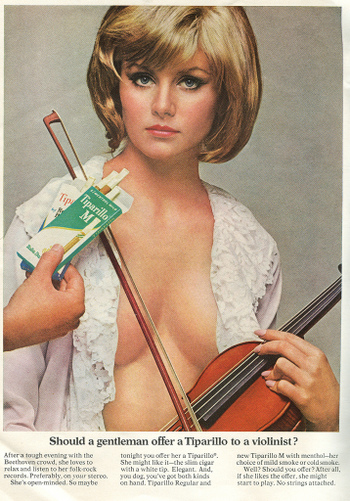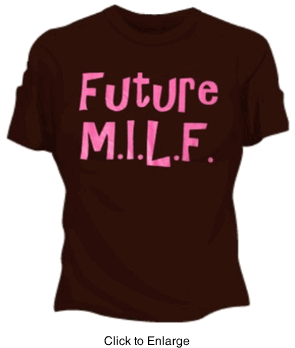I found these vintage (1967-68) ads for Tiparillo cigars at Found in Mom’s Basement. All answer the question, “Should a gentleman offer a Tiparillo to…” a particular type of woman.
After a tough evening with the Beethoven crowd, she loves to relax and listen to her folk-rock records. Preferably, on your stereo. She’s open-minded. So maybe tonight you offer her a Tiparillo. She might like it–the slim cigar with a white tip. Elegant. And, you dog, you’ve got both kinds on hand, Tiparillo Regular and new Tiparillo M with menthol–her choice of mild smoke or cold smoke. Well? Should you offer? After all, if she likes the offer, she might start to play. No strings attached.
Underneath that pocket of pencils there beats the heart of a digital computer. This girl has already catalogued and cross-indexed the Tiparillo slim, elegant shape. And the neat, white tip. She knows that there are two Tiparillos. Regular, for a mild smoke. Or new Tiparillo M with menthol, for a cold smoke. She knows. She’s programmed. And she’s ready. But how about you? Which Tiparillo are you going to offer? Or are you just going to stand there and stare at her pencils?
She’ll read anything she can get her hands on. From Medieval History to How-to-Build-a-24-Foot-Iceboat. Loves books. Loves new ideas. Okay. No doubt, she’s seen the unusual, slim Tiparillo shape. She’s been intrigued by the neat, white tip. She may even know that there are two Tiparillos. Regular, for a mild smoke. And new Tiparillo M with menthol, for a cold smoke. Your only problem is which to offer. P.S. If she accepts your Tiparillo, remember to fumble with the matches until she decides to light it herself. That way, she’ll have to put down the book.
I found these next two on ebay (all these vintage ads can be purchased on ebay, it turns out):
Is this the old did-it-with-mirrors ploy? Look again. Okay, that’s enough looking. What you’ve got on your hands are carbon copy twins. And what you’ve got in your hands are Tiparillo and Tiparillo M with menthol. Since Tiparillo is the slim, elegant cigar with the neat tip, would it be statistically correct to offer it to this census-taking twosome? Because all they really want is your name, address, phone number and a few other factual facts. But what they get sort of depends on what you offer.
“The doctor is a little late, sir. Will you have a seat?” She’s the best thing to hit dentistry since novocaine. “Hey Dummy,” your mind says to you, “why didn’t you have this toothache sooner?” Maybe if…well, you could offer her a Tiparillo. Or a Tiparillo M with menthol. An elegant, tipped cigar. Slim. And your offer would be cleverly psychological. (If she’s a bit of a kook, she’ll take it. If not, she’ll be flattered that you thought she was a bit of a kook.) And who knows? Your next visit might be a house call.
I will lead it to you, dear reader, to decide if there was supposed to be anything else “cleverly psychological” in any of these ads.


















